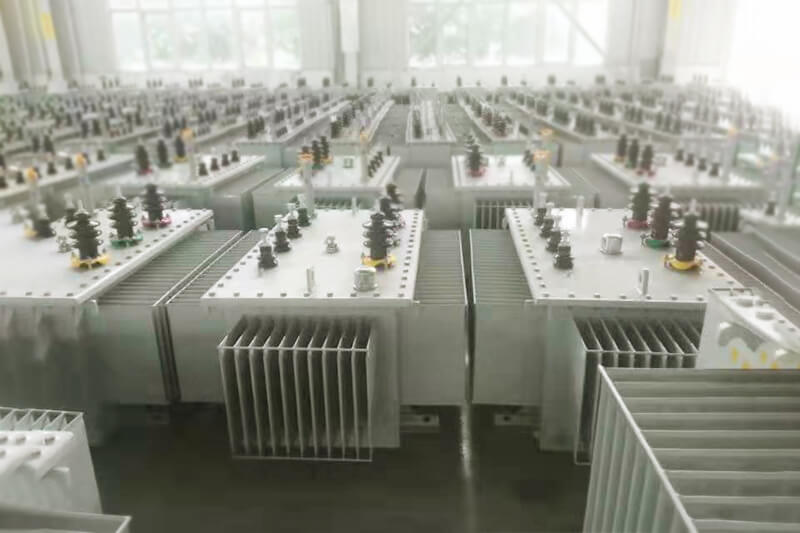In the power transmission and distribution system, transformers play a vital role. Oil-type transformers and dry-type transformers are two common types. Many power practitioners and corporate decision makers are thinking: Compared with oil-type transformers and dry-type transformers, which one is safer? Let's take a look at the difference between the two.
Analysis of the safety of oil-type transformers
Significant advantages of oil-type transformers
Excellent insulation and heat dissipation performance: Oil-type transformers use transformer oil as insulation and cooling medium. Transformer oil can effectively isolate high-voltage and low-voltage parts, greatly reducing the probability of leakage and short-circuit accidents. At the same time, through the natural circulation or forced circulation of oil, the heat generated by the transformer during operation can be quickly taken away. For example, in large power plants, oil-type transformers rely on efficient heat dissipation performance to ensure that the equipment can maintain normal operating temperature under high-load operation and reduce safety hazards caused by overheating.
Mature and reliable technical system: Oil-type transformers have a history of over 100 years and have accumulated a lot of experience in design, manufacturing and operation. Its structure and performance have been tested in long-term practice. In large-scale power systems, the reliable operation time of oil-type transformers can be as long as 20-30 years, and the technical maturity is widely recognized.

Potential risks of oil-type transformers
Fire and explosion hazards: Transformer oil is a Class C flammable liquid. It is very easy to burn or even explode under high temperature, arc or spark. According to statistics, in old substations, fire accidents caused by insulation aging, short circuit and other faults of oil-type transformers account for about 30% of the total number of transformer accidents. Once such an accident occurs, not only will the transformer be seriously damaged, but it may also pose a major threat to the safety of surrounding equipment and personnel.
Strict maintenance requirements: Oil-type transformers need to be regularly tested and maintained in all aspects of oil, covering multiple indicators such as insulation performance, water content, gas content, as well as oil filtration and replacement. If the maintenance is not in place, the decline in oil performance will directly affect the safe and stable operation of the transformer.
Safety analysis of dry-type transformers
Core advantages of dry-type transformers
Excellent fireproof performance: Dry-type transformers use solid insulation materials such as air and epoxy resin to eliminate the risk of fire and explosion from the root. Dry-type transformers are widely used in places with extremely high fire protection requirements, such as high-rise buildings, underground substations, and commercial centers. For example, in the power system of a large shopping mall, the use of dry-type transformers effectively avoids the possibility of fires caused by transformers and ensures the safety of personnel and property.
Environmentally friendly and pollution-free characteristics: Dry-type transformers do not produce oil pollution during operation and are very friendly to the environment. In addition, its structure is relatively simple, the maintenance workload is small, and there is no need for complex oil testing and treatment, which greatly reduces the environmental pollution problems that may occur during maintenance.
Convenient installation and deployment: Dry-type transformers are small in size and light in weight. There is no need to set up special transformer oil storage and treatment facilities during installation, which can save about 30% - 50% of the installation space. At the same time, it can reduce installation costs, and the installation process is also simpler and faster.

Limitations of dry-type transformers
Relatively low heat dissipation efficiency: Compared with oil-type transformers, dry-type transformers mainly rely on natural air cooling or forced air cooling, and the heat dissipation efficiency is obviously insufficient. In high temperature environments or when overloaded for a long time, dry-type transformers are very prone to overheating, which in turn affects the insulation performance and service life of the equipment. For example, in high-temperature areas in summer, the probability of dry-type transformers failing due to heat dissipation problems increases significantly.
Insulation moisture risk: The solid insulation material of the dry-type transformer is easily affected by moisture. Once it is affected by moisture, the insulation resistance will drop significantly, and in severe cases, it may cause insulation breakdown. Therefore, when using dry-type transformers in humid environments, effective moisture-proof measures must be taken, such as installing dehumidification equipment.
Comprehensive comparison of the safety of oil-type transformers and dry-type transformers
From the perspective of safety, dry-type transformers have significant advantages in fire prevention and environmental protection, and are particularly suitable for places with extremely high safety requirements. Although oil-type transformers have certain advantages in insulation and heat dissipation, the potential risks of fire and explosion cannot be ignored.
However, in practical applications, it cannot be simply determined that dry-type transformers are definitely safer than oil-type transformers. Choosing which transformer requires comprehensive consideration of factors such as cost, capacity, and use environment. For large industrial enterprises and power systems, oil-type transformers still have a wide range of applications due to their low cost and large capacity (up to hundreds of thousands of kilovolt-amperes), but maintenance management must be strengthened and effective fire and explosion prevention measures must be implemented to reduce safety risks.
With the continuous advancement of technology, dry-type transformers have made significant breakthroughs in heat dissipation and moisture resistance, such as the use of new heat dissipation materials and intelligent moisture-proof monitoring systems. In the future, dry-type transformers are expected to gradually replace oil-type transformers in more fields and become mainstream equipment in power systems.









Leave A Comment